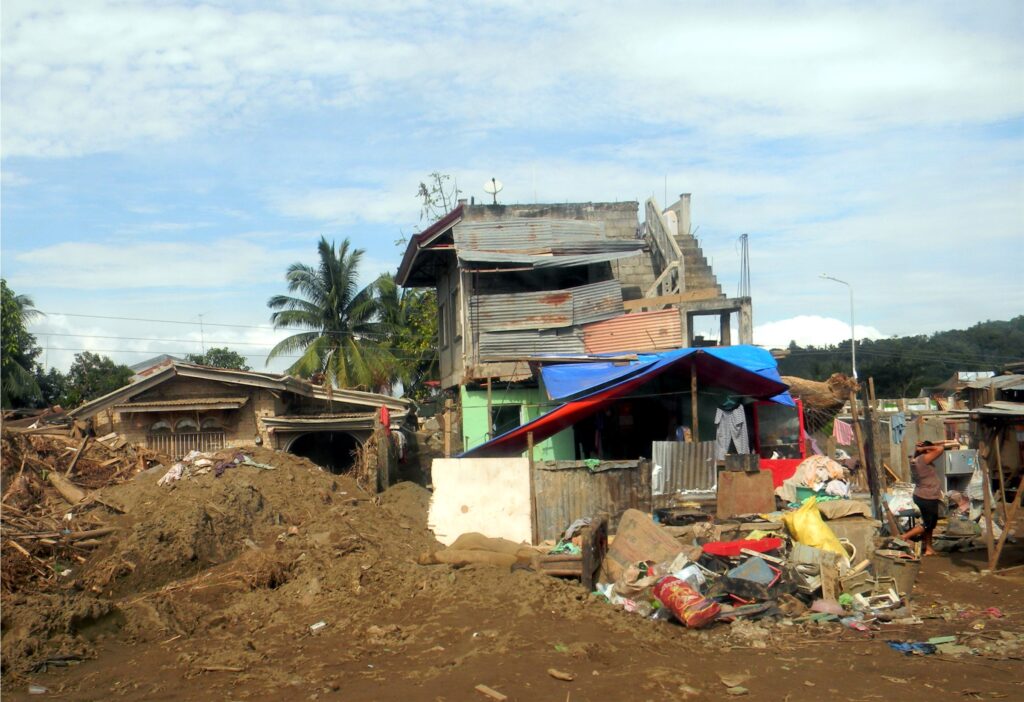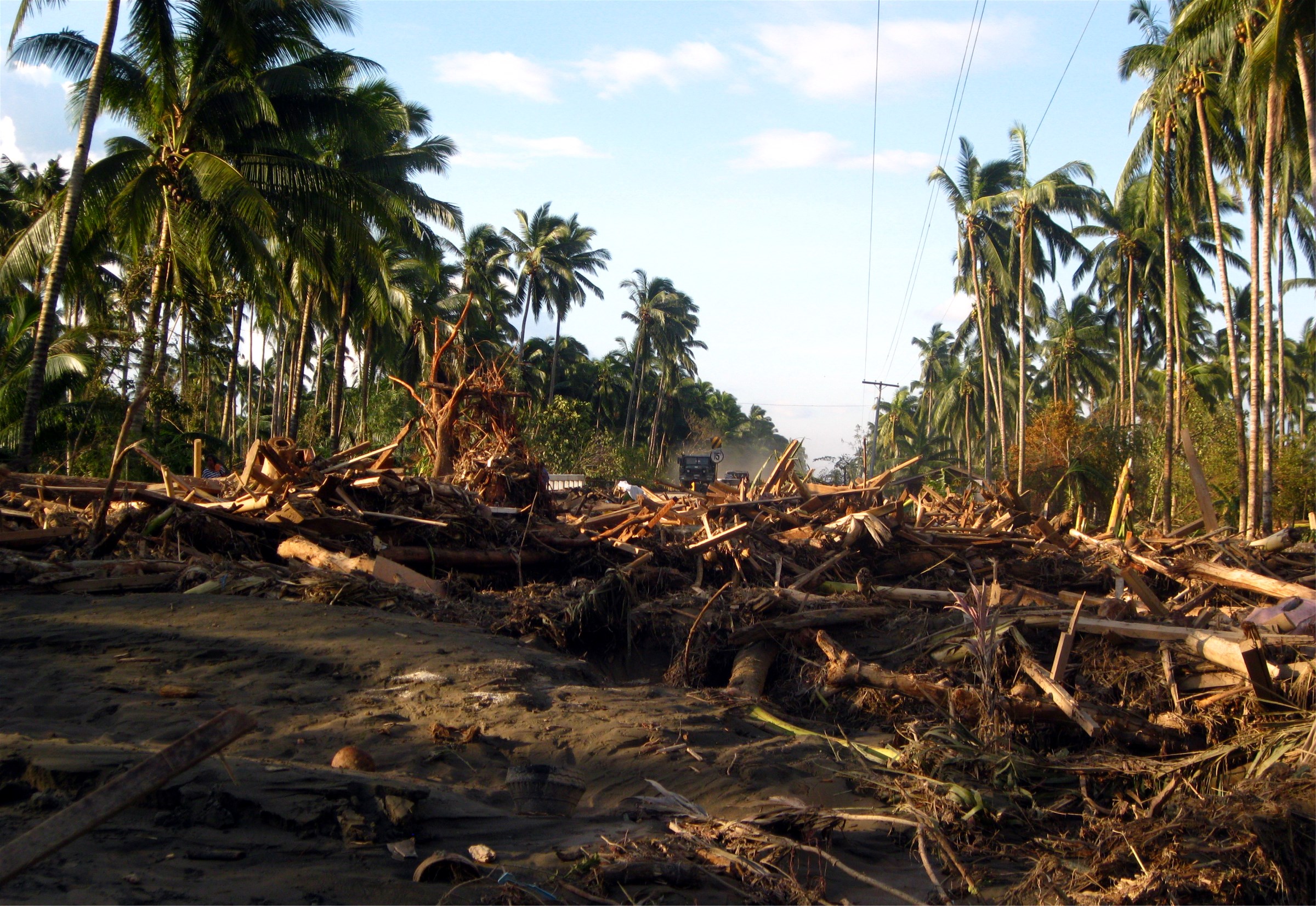Text and Photos by Henrylito D. Tacio
(First of Two Parts)
Every year, an average of 20 out of 36 tropical cyclones that develop over the Northwest Pacific basin cross the Philippines area of responsibility. “There is no month in the country which is free from typhoons,” the Philippine Atmospheric, Geophysical and Astronomical Services Administration (PAGASA) said in a statement.
In a symposium on Status of Research and Development Program and Mitigation Strategies for Typhoon- and Flood-Prone Areas held at Los Baños, Laguna some few years back, experts have observed that typhoon development in the country has been erratic in recent years and almost unpredictable with strongly varying movement and structure.
In the past, Mindanao was considered typhoon-free, but now cyclones no longer spare the island. This was particularly true in Davao Region, whose inhabitants never experience typhoons in their lives. Not until Super Typhoon Pablo (international name: Bopha) made landfall late on December 3, 2012. The storm caused widespread destruction in the region.
In 2021, Super Typhoon Odette (Rai) made landfall nine days before Christmas on Siargao Island. “Shortly after landfall with winds at 160 miles per hour (mph), it underwent an eyewall replacement cycle and decreased in strength, but winds remained at 150 mph,” a report said.
In 2011, Mindanao was also hit by another strong typhoon named Sendong (Washi). On December 16, severe tropical storm Sendong brought 10 hours of torrential rains that triggered disastrous flash flooding over Mindanao, an area that rarely experiences tropical cyclones.
Typhoons used to be moderate in Northern Luzon and Batanes, but it has completely changed as typhoons now frequent these areas.
“Weather patterns could become unpredictable, as would extreme weather events, hurricanes could become much stronger and more frequent,” wrote Lulu Bucay in a climate change brochure produced by the Department of Environment and Natural Resources (DENR).
As stated in the executive report of Getting a Grip on Climate Change in the Philippines, a World Bank publication, “by the end of this century, tropical cyclones are expected to intensify, with a projected increase in the average instantaneous maximum wind velocity at the Philippine coast.”
Climate change has, indeed, significantly contributed to the emergence of more intense typhoons and higher storm surges, contends another World Bank report, Turn Down the Heat: Climate Extremes, Regional Impacts and the Case for Resilience.
The megacity of Davao has traditionally escaped the wrath of typhoons. But not the incessant rains these intense storms bring. When typhoon Vinta (Tembin) entered Davao City two days before Christmas in 2017, some areas were flooded.
The recent flooding was just a precursor of what will happen in the coming years. Former Press Secretary Jesus G. Dureza believes the constant flooding now happening in Davao City is due to sea-level rise.
Sea level rise is another consequence of climate change. In 2007, the Nobel prize-winning International Panel on Climate Change (IPCC) estimated that sea levels might rise – as a result of climate change – by between 18 centimeters and 59 centimeters in the coming century. The Philippines ranks fourth in the Global Climate Risk Index. Fifteen of the 16 regions of the country are vulnerable to sea-level rise.
In Mindanao, a six-meter sea level rise in the Davao Gulf could submerge the coastal area of Davao City. When he was still alive, city councilor Leonardo Avila III said in a forum that Agdao district, Panacan, Sta. Ana wharf, part of the Lanang, Bajada, and Matina areas, the whole downtown area, including the City Hall, will be completely underwater. “These areas will virtually be part of the Davao Gulf,” he said.


It is already happening. “My calculation is that (the sea level rise) has risen by one foot over a period of 20 years,” Dureza wrote some years back in his column, Advocacy Mindanao.
“Hence, rain waters and floods no longer easily flow or empty out into the sea,” he continued. “They are clogged in the waterways and spill out in the riverbanks.”
Dureza added that when floodwaters rush down during high tide, they get stuck, at times and worse, causing a “backflow” of seawater during high tide.
“When seawater rises high, it flows back inland through rivers,” he wrote. “Hence, low-lying areas or subdivisions or residential areas around or near riverbanks are in trouble. I know this because I personally witnessed how the sea level had gone up over the years.”
American bestselling author Tom Anthony is very much aware of this, too. He came to the Philippines when he married his Filipina wife, whom he met in Singapore. Since his wife is from Mindanao, he decided at that time to settle in Davao City.
In 2013, Anthony built a house near a beachfront. The place was so beautiful as it reminded him of his home in California. Trees were trimmed all over; there was also a cemented pathway along the shoreline.
Then, something happened. After a vacation in the United States and returned home, he observed that there were already cracks in the cemented pathway. Some portions are no longer passable as it is dangerous to walk on them.
In fact, the dead-end of the long road from the entrance is now placed with orange signage with the word: DANGER. The cemented fence of a house built near the seashore may soon give way as the waves of the sea kept on encroaching the backyard.
“This is a proof that sea level rise is for real,” said Anthony, who wrote the bestselling Rebels of Mindanao. “I think people should stop thinking that climate change is a state of mind. We need to do something about it now before it’s too late.”
Sea level rise will have a grim consequence, economic-wise. In a conference on strengthening river basin organizations in Davao City in 2015, Lorenzo Tan, executive director of Worldwide Fund for Nature (WWF), declared: “If you see rising sea levels, Mindanao is at ground zero.”
Davao City was a case in point. It was among the 12 key cities in the country that was included in the Business Risk Assessment and the Management of Climate Change Impacts study done by WWF along with the Bank of the Philippine Islands (BPI) Foundation Inc.
“The study was conducted to help city planners assess the impacts of climate change in their communities, identify opportunities and decide on a sustainability strategy, site-specific interventions that will allow the city to retain its economic viability,” Tan told Business World.
Tan noted that Davao runs a close second to Cebu in terms of tonnage shipped through its ports. “Located along the relatively shallow channel between the city and Samal Island, these port facilities are a nerve center for Davao City’s economy, and serve a variety of ships handling both cargo and passengers,” the risk assessment said.
The Philippines, with more than 7,000 islands, is one of the most vulnerable countries in the world to weather-related extreme events, earthquakes, and sea-level rise.
“Absent of land barriers, the Philippines is exposed directly to multiple climate-related hazards such as typhoons (in the northern and eastern parts), floods (in central Luzon and southern Mindanao), landslides (based on terrain), and droughts, making the Philippines more vulnerable to climate risks than other Southeast Asian countries,” the World Bank report said.
But Filipinos can do something about it. As Director Nicomedes P. Eleazar of the Bureau of Agricultural Research said, “Science teaches us that if we act decisively and collectively, soon we can manage climate change. The sooner we act on this, the cheaper it will be for the country.”

